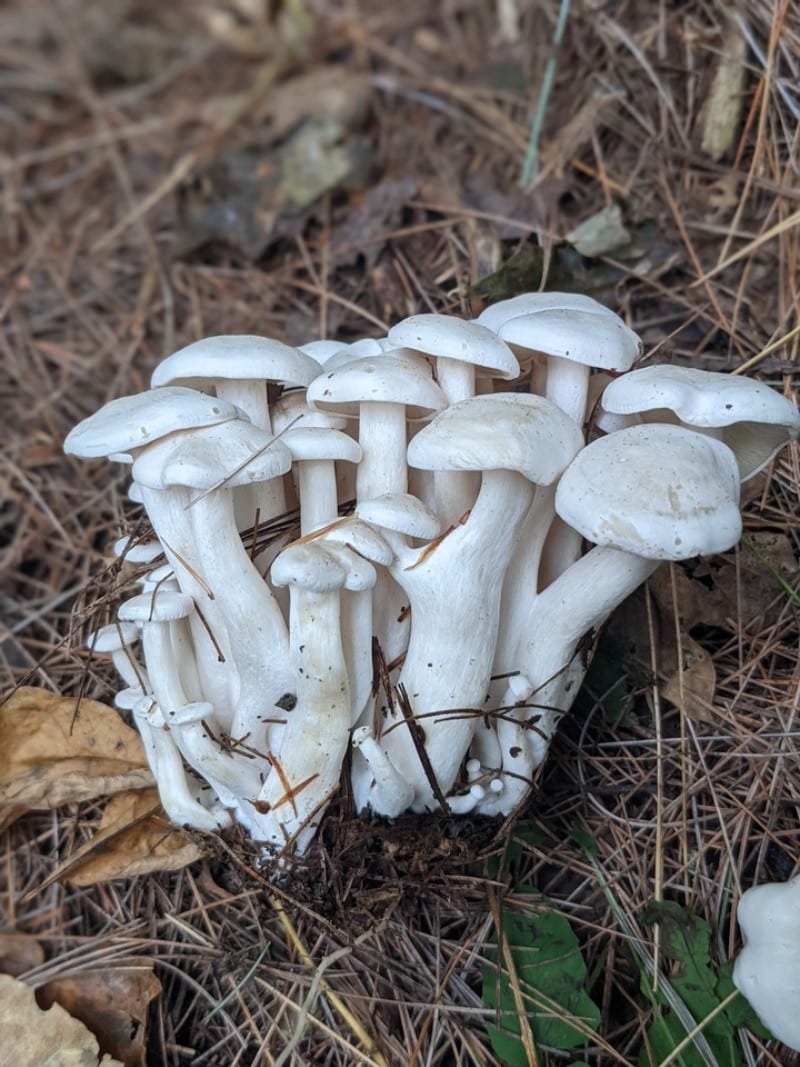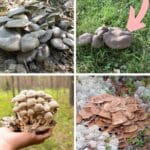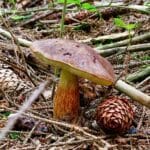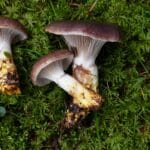The fried chicken mushroom (Lyophyllum decastes) is a delectable edible species that appears in fall in most areas. It grows in dense clusters in urban and suburban areas, often along roadsides. This earned it the common name chicken of the gravel, which you’ll also hear it referred to a lot.
The common names of this mushroom can cause it to be confused with the other chicken mushroom, Chicken of the Woods (Laetiporus sulphureus). These are two very different mushrooms—Chicken of the Woods is a bright orange polypore, while the fried chicken mushroom is grayish and has gills.
- Scientific Name: Lyophyllum decastes
- Common Names: Fried chicken mushroom, chicken of the gravel, clustered Lyophyllum
- Habitat: On the ground, disturbed areas, urban and suburban
- Edibility: Edible

Jump to:
All About The Fried Chicken Mushroom
The fried chicken mushroom is a sought after edible species with a texture and appearance similar to cooked chicken. It is widely sought by foragers in areas where it grows. It fruits across North America, but is more concentrated in the northeast and northwest, being almost absent in the center of the country.
The fried chicken mushroom might actually be a species group – a Lyophyllum decastes group of similar looking fungi. Or, it could be that this species just has extremely variable cap coloring. This makes it slightly complicated to identify but as long as you carefully match all the key characteristics, you should be okay.
This popular edible mushroom is commercially cultivated in Japan. It isn’t this exact species, but the cousin of it which is very similar in taste and texture – an Asian species, Lyophyllum shimeji.
It was first described to science in 1818 by the renowned Swedish mycologist Elias Magnus Fries. He named it Agaricus decastes. However, subsequent research led to its reclassification under the genus Lyophyllum by German-born American mycologist Rolf Singer in 1951. Over the years, this species has been moved around taxonomically, at various times being named Agaricus aggregatus, Clitocybe decastes, and Lyophyllum aggregatum.
The word decastes comes from Latin, meaning ‘occurring in tens.’ Interestingly, it is not uncommon to stumble upon groups of exactly ten fried chicken mushrooms during forays into the woods. This curious pattern is part of the mushroom’s allure – if you find these, don’t forget to count how many are in the cluster!
Beyond its culinary and medicinal applications, Lyophyllum decastes plays a role in environmental conservation. In Japan, this mushroom is utilized in bioremediation projects to detoxify polluted sites and in water purification systems. Its ability to thrive in disturbed soils makes it an ideal candidate for ecological restoration efforts.

Fried Chicken Mushroom Identification Guide
Season
The mushroom is prolific in summer, fall, or spring, depending on the region. In California and the PNW, this species is known to fruit from fall through spring. The rest of the country usually sees them in late summer and fall.
Habitat
This is a saprobic species, meaning it obtains nutrients by decomposing organic matter. It usually grows in dense clusters on disturbed soil, such as roads, paths, or landscaping areas. It isn’t uncommon to find it growing in urban and suburban areas, often at the edge of a road or driveway where it turns into grass. This is how it earned its other common name, chicken of the gravel — it literally will grow in that gravelly places. It is also found in woods, particularly in areas rich in leaf litter.
This species grows on the ground only; it does not grow on trees or from wood. It almost always grows in clusters, often extremely large and dense ones. Sometimes, you’ll find them individually, but that is less common. The groups are often scattered in a broad area, so where there is one cluster, another is not far away.
It’s widely distributed in North America, Europe, and other parts of the world. In North America, it is primarily concentrated on the east and west, while it is almost absent in the middle of the country.

Identification
Cap
The fried chicken mushroom ranges from 1.6 to 4.7 inches across. Initially rounded, like a grocery store button mushroom, it gradually flattens out. With advanced maturity, it might flip upwards at the edges. It is often irregular and wavy or lumpy in appearance. The edge of the cap is often scalloped, too.
The cap’s color varies, ranging from shades of gray-brown to yellowish brown. When young, it may have silky or silvery streaks of color across the top. The surface is smooth, shiny, and moist or sticky to the touch. However, it is not slimy.
Gills
The gills of the fried chicken mushroom are closely packed and white. With age, they may develop a slight yellow-brown tinge. The gills are attached to the stem and may run down it slightly.
Stem
The stem measures between 1.2 to 2.4 inches long. It is smooth and often slightly curved, and it may have thin vertical fibers along it. The color of the stem ranges from white to pallid, occasionally with brown discolorations near the base.
Flesh
The flesh of the fried chicken mushroom is thin and white. When cut, it does not undergo any noticeable color changes.
Odor and Taste
The odor is typically mild, and the taste is pleasant or faintly radish-like.
Spore Print
The spore print is white.
Key Features of the Fried Chicken Mushroom
As mentioned previously, this species may be complex or simply one very variable individual species. This means that identification might be a little tricky because the cap color is highly variable. However, if you match these points, there’s a pretty good chance you’ve found the fried chicken mushroom.
- Grows on the ground
- Appears in large, dense clusters – sometimes massive clusters
- Grows on disturbed ground like paths, landscaped areas, roadsides, and along sidewalks. May also grow in the woods in dense leaf litter.
- Mild smell and taste
- A cap that is whitish, yellowish, brownish, or grayish (based on potential lookalikes, it may be wise to avoid whitish-colored fried chicken of the woods-looking species)
- White gills, may turn yellowish with age
- White spore print




Fried Chicken Mushroom Lookalikes
White Domecap (Leucocybe connata)
This less-common yet potentially toxic lookalike is problematic. It has a limited distribution in North America (that is reported…) but has appeared in both the northeast and northwest. This species has a white cap, grows on the ground, forms dense clusters, and grows in disturbed areas like roadsides. As you can see, it has a lot in common with the fried chicken mushroom if the fried chickens happen to be white in color.
There are several small important differences, though. The white domecap does not flatten out with age. The cap widens, but it never completely flattens. Instead, it retains a slightly inrolled edge. Also, of course, the white cap and stem are distinctive. If the fried chicken mushroom is brownish, yellowish, or grayish, then there is no confusion with this species.
The white domecap used to be considered perfectly edible, but recent research project found toxins in it that may cause DNA mutations. This research has been challenged, but a clear verdict has yet to be given. Until then, we recommend caution with this one.

Clitocybe dilatata
This Pacific Northwest species also looks a lot like the fried chicken mushroom if the fried chicken mushroom is white. This species is thought to be poisonous and should be avoided. It grows in clusters in disturbed areas like roadsides, paths, and landscaped areas. It is a common species in the Pacific Northwest, so if you are seeking fried chicken mushrooms there, be careful with this one.
The cap is white or grayish and smooth and dry. The dry cap is different from the chicken of the gravel’s moist cap. It is also usually humped in the center or deformed-looking. With age, it becomes depressed in the center. When it is dry out, the cap is chalky white. In wet weather, it is translucent or spongy.
It has a sour or unpleasant taste, which is also different from the fried chicken mushroom.

Entoloma species
There are a lot of Entoloma mushroom species that bear a close or passing resemblance to the chicken of the gravel. And, a lot of Entoloma species are toxic and cause gastrointestinal illnesses. So, it is essential to be cautious about these.
Many Entolomas have thick buff, white, or grayish caps and whitish gills, just like the fried chicken mushroom. There is a key difference, though; the spore print is salmon pink, not white. This is why spore prints are so important! If you are ever unsure, do that spore print and be sure.
Many times, though, you can see the salmon pink spores staining the gills without doing the spore print, and then you know straight away it’s not the fried chicken mushroom. The flesh of the Entoloma is usually pinkish as well, not white, so that’s another clue.

Large White Leucopaxillus (Leucopaxillus albissimus)
This mushroom looks a lot like a white fried chicken mushroom. It differs by having a smooth, dry cap—not a sticky one like the chicken mushroom. This mushroom also gets quite large, growing between 4 and 12 inches wide. It primarily grows under coniferous trees and is less likely to be seen in disturbed or urban landscapes. The large white Leucopaxillus is not toxic, but it doesn’t taste good, so it is considered inedible.

Honey Mushroom (Armillaria mellea)
While both mushrooms may form clusters, the honey mushroom can be differentiated by its yellow-brown to reddish-brown cap, which is slightly scaly. There is also a distinctive ring around the stem.

Fried Chicken Mushroom Edibility and Preparation
The fried chicken mushroom is edible, and a top one at that. Its texture and appearance resemble cooked chicken. The taste is mild and slightly nutty, and the texture is chewy and meat-like.
This mushroom, in Japan, is called “hatake-shimeji.” It’s not exactly the same species, but they are closely related and prepared the same way. It is used in a popular dish called takikomi goha. This is seasoned rice with meat and vegetables, using seasonal ingredients. These mushrooms are also used in o-suimono, a Japanese soup with mushrooms, herbs, and tofu in a clear dashi broth.
- Keep freshly picked mushrooms in a paper bag in the fridge until you’re ready to cook.
- For longer storage, slice cleaned mushrooms or leave them whole and freeze them on a tray before transferring them to freezer bags.
- Alternatively, dehydrate the mushrooms and rehydrate in warm water or wine when ready to cook.
- Wipe caps with a damp paper towel, trim, and scrape stems to remove debris. Or, rinse under cool running water and pat dry.
- Sauté, fry, add to omelets, use as a pizza topping, or use in soups and stews.

Medicinal Properties Of The Fried Chicken Mushroom
Lyophyllum decastes isn’t just sought after for its culinary uses; it’s also been the subject of intriguing research for its potential health benefits:
Cholesterol Reduction: Studies on rats have shown that consumption of L. decastes can possibly significantly decrease cholesterol, serum triglycerides, and phospholipids. This suggests potential cardiovascular benefits in humans.
Cancer and Radiation Protection: Compounds isolated from L. decastes have demonstrated the ability to inhibit cancer tumor growth in mice and protect cells from radiation damage. While further research is needed, these findings hint at the mushroom’s medicinal potential.
Research into the medicinal properties of the fried chicken mushroom is limited, and further investigation is required to fully understand its potential benefits.

Common Questions About The Fried Chicken Mushroom
Is it safe to eat fried chicken mushrooms without cooking them?
No, it is not safe to eat fried chicken mushrooms raw, as they can cause gastrointestinal discomfort. It is recommended that the mushrooms be cooked thoroughly. Even when cooked, some individuals may still experience sensitivity to this mushroom.
What type of mushroom is often compared to chicken in taste and texture?
Laetiporus sulphureus, commonly known as a sulfur shelf, chicken of the woods, chicken mushroom, or chicken fungus, is renowned for its chicken-like flavor and texture once cooked. The fried chicken mushroom (Lyophyllum decastes), a very different-looking mushroom, is also similar to chicken in texture and appearance.









Leave a Reply